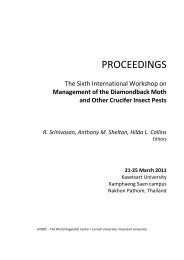Leguminous Vegetable Cultivation and Seed Production S ...
Leguminous Vegetable Cultivation and Seed Production S ...
Leguminous Vegetable Cultivation and Seed Production S ...
Create successful ePaper yourself
Turn your PDF publications into a flip-book with our unique Google optimized e-Paper software.
SEED PRODUCTION AND MANAGEMENT OF MUNGBEAN AND SOYBEAN 369<br />
Under those circumstances, it is better to harvest at the onset of rain <strong>and</strong> dry the<br />
plants in a well-ventilated area. They can be air-dried slowly to enable threshing<br />
later.<br />
Threshing <strong>and</strong> cleaning<br />
High cylinder speeds of combines or threshers will result in multiple fractures <strong>and</strong><br />
deep-seated bruises, especially in large-seeded soybean or mungbean <strong>and</strong> in seeds<br />
with lower moisture content (Moore 1957, 1972; Roberts 1972a). A 700 rpm cylinder<br />
speed is better than 1155 rpm. Soybean seeds impacted at 12-16% seed moisture<br />
germinated satisfactorily; those impacted at 8-10% <strong>and</strong> 18-20% moisture germinated<br />
poorly (Bunch 1960).<br />
In developing countries, soybean <strong>and</strong> mungbean usually are threshed by h<strong>and</strong>,<br />
either by beating pods inside a bag with sticks or by trampling with animals or small<br />
tractors. Such harsh treatment can result in mutilated seeds. Studies at IITA showed<br />
that combine threshing is inferior to h<strong>and</strong> threshing <strong>and</strong> beating pods inside a bag<br />
(Nangju et al 1978). Possibly the cylinder speed was not set properly or the seed<br />
moisture content at threshing was too low.<br />
After threshing, the seeds should be cleaned to remove plant debris, weed seeds,<br />
dirt, <strong>and</strong> other extraneous materials that favor seed deterioration. The seeds should<br />
be examined for purity <strong>and</strong> variants should be removed. <strong>Seed</strong>s with mottling due to<br />
SMV should be removed.<br />
Testing for viability <strong>and</strong> longevity<br />
A number of factors can influence seed quality <strong>and</strong> viability during production.<br />
Poor seed with low viability will be even poorer after storage. Therefore, seed lots<br />
need to be examined before storage. A good-looking seed may not necessarily be<br />
good quality. <strong>Seed</strong> viability is usually measured when the seed is planted, but it is<br />
also measured for industrial purposes (MacKay 1978). Incubator germination, field<br />
emergence, tetrazolium, seedling growth rates, <strong>and</strong> seed leachates are some of the<br />
tests used to evaluate seed viability (Kueneman 1982, MacKay 1978).<br />
Genotypic differences in seed longevity have been reported (Kueneman 1983,<br />
Paschal <strong>and</strong> Ellis 1978). Within a variety, a number of preharvest <strong>and</strong> postharvest<br />
factors can influence seed longevity. These tests of seed longevity have been<br />
proposed: seed storage (normal aging of seeds), accelerated aging stress, cold stress,<br />
hot water pregermination stress, osmotic stress, thermo stress during germination,<br />
<strong>and</strong> methanol stress (Kueneman 1982). Accelerated aging, pregerrnination, thermo,<br />
<strong>and</strong> methanol stress are recommended for use in breeding for seed longevity.<br />
<strong>Seed</strong> storage<br />
Factors to consider in storing seeds until planting are initial seed moisture content,<br />
genotype, temperature, RH, the container in which the seed is packed, <strong>and</strong> the<br />
method of packing. At AVRDC, seeds are sun- or air-dried to 8% moisture content<br />
for medium-term storage at 2-5 °C <strong>and</strong> 40-45% RH. Under these conditions,<br />
soybean seed can be stored for 20 yr (AVRDC 1985, Cromarty et al 1982). With<br />
8.1-9.4% seed moisture content, soybean seed can be stored at 10 ° C for 10 yr; at 13%
















